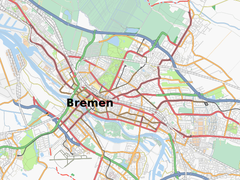User:Skybunny/Places

|
| Description |
| The place tag is used on a single node to mark the centre of a named settlement as well as on the whole area to mark its extent. |
| Group |
| Tags |
Places are a family of OpenStreetMap objects used to describe general geographic map objects, and one of the earliest created in the system.
Historically, places have been used to describe populated settlements (such as city, town, village, hamlet), neighbourhoods, and also unoccupied identifiable locations ranging from very large (continents and oceans) down to very small features (localities).
Common tagging used with the place key to describe OpenStreetMap features can be found at place=*.
How to map
![]() A place can be a single node tagged with place=* roughly in the perceived centre of the place. Examples of an appropriate centre might be a town or village square, the primary intersection of a settlement's transport routes, or an appropriate central monument.
A place can be a single node tagged with place=* roughly in the perceived centre of the place. Examples of an appropriate centre might be a town or village square, the primary intersection of a settlement's transport routes, or an appropriate central monument.
A place can also be (best) described using a relation, with members.
![]() +
+![]() +
+![]() A place can also be created using a relation, with members, when one wants to show the area that a place comprises, rather than only its center point. A place relation consists of:
A place can also be created using a relation, with members, when one wants to show the area that a place comprises, rather than only its center point. A place relation consists of:
- The relation itself
- One or more member ways that comprise the shape of the boundary
- One or more member nodes that describe other aspects of the relation (such as the optional-to-use
labelmember)
![]()
An encouraged usage until recently was to apply the place=* tag to areas. The problem is that OSM Areas, by themselves, cannot have associated nodes. Historical experience has shown that relation member nodes are extremely useful (especially for machine data consumers) to help interpret and render place "areas" created in OSM, whether to provide additional information, or for backwards compatibility.
See the place relation for best practices for creating boundary relation shapes.
Proposals
Proposed_features/new_place_values(abandoned)
Questions
What makes a road belong to a city?
Ideally, an administrative border (boundary=administrative) should surround a place. This makes it easy to automatically determine "where" every place is; this is in fact what Nominatim does.
The Karlsruhe Schema lets you define which postcode and postcode-area-name each way or house has.
For many areas, the information on where exactly an administrative border is is not freely available to use for OSM. A common fall-back method is then to use the nearest place=* node for an estimate.